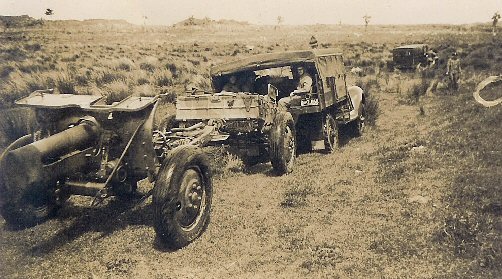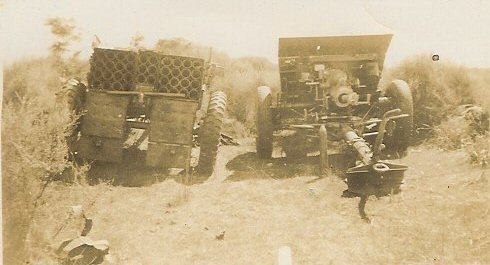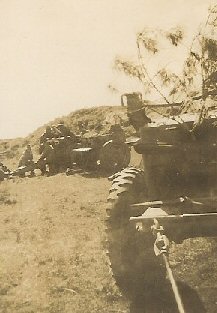|
Home Tales index


Chapter 2 Rank brings Resonsibilty
Part 4 Guns and Tractors
373649 Arthur H Paddison, 2nd Field Regiment, NZA
back index next
Vehicles that tow guns are called 'tractors'.
The Marmon was an adaptation of a long nosed Ford with four wheel drive to four single heavy duty tyred wheels; the chassis was very flexible, for off road work the bonnet and cab doors needed to be on the first latch otherwise they would get permanently twisted out of alignment. There was a hatch over the passenger's seat so that the No 1 could stand up and see what was going on.
|
The spare tyre was secured between the cab and the tray, which had a shaped floor made from cleated plate, wooden sides with a metal frame for a roll-up canopy.
The seats faced the centre and were padded wood with a canvas covering. There was no tailgate. Across the chassis at the rear was a spring mounted towing hook. Some tractors had winches and ground anchoring plates with long steel ground pins plus strong pulleys.
Connecting the tractor to the gun was a two-wheel trailer called a limber, which had a full-width flap at the rear giving access to forty rounds of ready use ammunition; most being HE, (High Explosive) the rest being Shrapnel with a few solid AP shot.
At the front, the limber had a heavy duty tow bar; at the rear a towing hook for the gun, all towing hooks had a device to prevent them from accidentally coming apart ; guns are heavy and the consequence of one careering around on its own, spells trouble. Each section (2 guns) also had an ammunition truck.
When first made, the gun and limber, had spoked cart wheels and were towed by a team of six horses, two of the crew rode on top of the limber and some rode the offside (right-hand) horse of each pair. The No 1 rode a saddle horse.
| 
Marmon and gun ready to roll
|
To fit in with the mechanised army, the guns were fitted with an axle extension bracket called a Martin-Parry adaptor, which kept the gun at the original height on tyred road wheels. The limber was similarly equipped.

Marmon towing a 4.5-inch howitzer, Foxton
The main framing member of the gun carriage is the trail, a heavy steel tube about 150 mm in diameter, connected to the axle at the front and stiffened with braces running out to the ends of the axle. To the rear end a spade bracket is clamped and riveted.
The spade as the name implies is a blade fixed at right angles across the trail and shaped so that it digs into the ground when the gun is fired and prevents the carriage from taking off under the shock of recoil. The bracket also has a hand grip on either side and the towing eye bracket on the end, which is formed so that the towing eye can turn to allow for the changing ground contour under the gun and limber when moving over rough ground.

Gun and limber from rear
Mounted on top is the traversing lever which can be folded forward along the trail when the gun is being towed. Its purpose is to provide leverage when the gun is being manoeuvred by the crew.
At the front, forming the junction with the axle, is another bracket with an extension to carry the pivoting saddle, that supports the gun and buffer and recuperator system casting, mounted on trunions that permit the gun to be elevated so that it can fire shells to varying distances.
|
Without going into too much detail, the front end of the buffer and recuperator is attached to the carriage and the rear is attached to the breech end of the gun by a large nut.
When a gun is fired the propellant charge, contained in a brass case attached to the round, ignites; it doesn't explode, but burns very rapidly, generating considerable pressure in all directions.
Side pressure is contained by the circular shape of the barrel, forward pressure forces the projectile up the spout and the pressure to the rear bears on the inside face of the breech block, which, being locked into the end of the barrel drags the barrel backwards, in a word the gun
recoils.
| 
Gun position in sandhills
|
|
|
The B&R System is in fact a large shock absorber, slowing down the backward movement of the gun by forcing hydraulic oil from one chamber into another and also, further compressing air, already under considerable pressure, so that when recoil ceases the compressed air pushing on a piston, causes the gun to return to the firing position. Seats for 2 & 3 are mounted on brackets attached to the trail on either side of the breech.
Aiming the gun is usually effected by a dial sight mounted on a shield bracket in front of 3s seat. The sight is carried in a dust proof leather case on the other side of the gun in front of 2s seat. It's important to keep sights clean at all times; taking time out to clean them in an emergency can spell disaster.
AH Paddison, 2007
back index next
Tales From The Trails index |
Home page
|